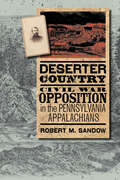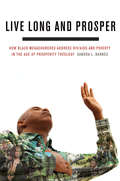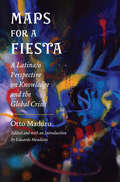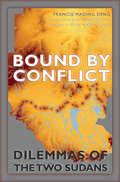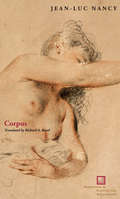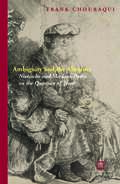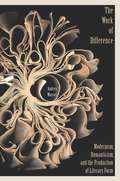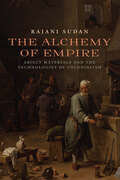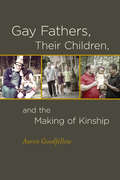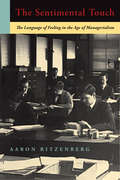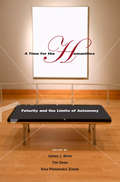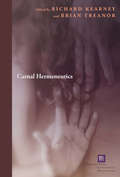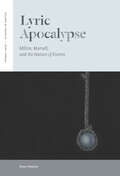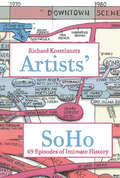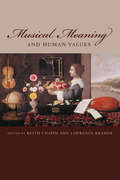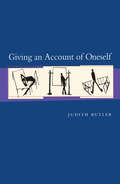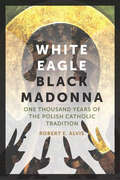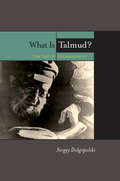- Table View
- List View
The Imperative to Write: Destitutions of the Sublime in Kafka, Blanchot, and Beckett
by Jeff FortIs writing haunted by a categorical imperative? Does the Kantian sublime continue to shape the writer’s vocation, even for twentieth-century authors? What precise shape, form, or figure does this residue of sublimity take in the fictions that follow from it—and that leave it in ruins?This book explores these questions through readings of three authors who bear witness to an ambiguous exigency: writing as a demanding and exclusive task, at odds with life, but also a mere compulsion, a drive without end or reason, even a kind of torture. If Kafka, Blanchot, and Beckett mimic a sublime vocation in their extreme devotion to writing, they do so in full awareness that the trajectory it dictates leads not to metaphysical redemption but rather downward, into the uncanny element of fiction. As this book argues, the sublime has always been a deeply melancholy affair, even in its classical Kantian form, but it is in the attenuated speech of narrative voices progressively stripped of their resources and rewards that the true nature of this melancholy is revealed.
Deserter Country: Civil War Opposition in the Pennsylvania Appalachians (The North's Civil War)
by Robert M. SandowDuring the Civil War, there were throughout the Union explosions of resistance to the war -from the deadly Draft Riots in New York City to other, less well-known outbreaks. In Deserter Country, Robert Sandow explores one of these least known "inner civil wars", the widespread, sometimes violent opposition in the Appalachian lumber country of Pennsylvania.Sparsely settled, these mountains were home to divided communities that provided safe-haven for opponents of the war. The dissent of mountain folk reflected their own marginality in the face of rapidly increasing exploitation of timber resources by big firms, as well as partisan debates over loyalty. One of the few studies of the northern Appalachians, this book draws revealing parallels to the War in the southern mountains, exploring the roots of rural protest in frontier development, the market economy, military policy, partisan debate, and everyday resistance. Sandow also sheds new light on the party politics of rural resistance, rejecting easy depictions of war-opponents as traitors and malcontents for a more nuanced and complicated study of the class, economic upheaval, and localism.
Live Long and Prosper: How Black Megachurches Address HIV/AIDS and Poverty in the Age of Prosperity Theology
by Sandra L. BarnesThis pioneering new study of the Black megachurch phenomenon brings nuance and depth to the question, Are Black megachurches more focused on prosperity than on people?Black megachurches and their pastors are often accused of failing to use their considerable resources to help the poor; focusing on prosperity theology rather than on social justice; requiring excessive monetary and time commitments of members; and pilfering church coffers for the their personal use. The debate rages on aboutwhether these congregations are doing all they can to address specific challenges facing African American communities. Live Long and Prosper is a refreshing, innovative study that reaches beyond superficial understandings of the Black megachurch phenomenon in a piercing interrogation of how powerful megachurches address (or fail to address) two social crises in the Black community: HIV/AIDS andpoverty.Live Long and Prosper offers an intriguing examination of sixteen representative Black megachurches and explores some of their motivations and subsequent programmatic efforts in light of prosperity or “health and wealth” theology. Professor Barnes makes the case that the Black megachurch is a complex, contemporary model of the historic Black church in response to globalism, consumerism, secularism, religious syncretism, and the realities of race. She contends that many of these megachurches hold unique characteristics of adaptability and innovation that position them well to tackle difficult social issues. Prosperity theology emphasizes two characteristics—physical health and economic wealth—as examples of godly living and faith. This book considers whether and how efforts to address HIV/AIDS (a “health” issue) and poverty (a “wealth” issue) are influenced by church and clergy profiles; theology, in general; and prosperity theology, in particular. Frame analysis informs this mixed-methodological study to compare and contrast experiences, theological beliefs, pastoral profiles, and programs.Live Long and Prosper is a must-read for general readers, academics, and students alike—indeed, anyone interested in the contemporary Black megachurch’s response to social problems and the link between theology and social action. It is at once a fascinating, readable narrative and a rich piece of scholarship complete withextensively documented endnotes, statistics, informative charts and tables, and an exhaustive bibliography.
Maps for a Fiesta: A Latina/o Perspective on Knowledge and the Global Crisis
by Otto MaduroWhat can theology offer in the context of neoliberalism, globalization, growing inequality, and an ever more ecologically precarious planet that disproportionately affects the poor? This book, by one of the country’s best-known Latino theologians, explores possibilities for liberation from the forces that would impose certain forms of knowledge on our social world to manipulate our experience of identity, power, and justice.Beautifully written in a refreshingly direct and accessible prose, Maduro’s book is nevertheless built upon subtly articulated critiques and insights. But to write a conventional academic tractatus would have run counter to Maduro’s project, which is built on his argument that ignorance is masked in the language of expertise, while true knowledge is dismissed because it is sometimes articulated in pedestrian language by those who produce it through the praxis of solidarity and struggle for social justice.With a generosity and receptivity to his readers reminiscent of letters between old friends, and with the pointed but questioning wisdom of a teller of parables, Maduro has woven together a twenty-first-century reply to Marx’s “Theses on Feuerbach.” Neither conventional monograph nor memoir, neither a theological nor a political tract, but with elements of all of these, Maps for a Fiesta arrives as Maduro’s philosophical and theological testament—one that celebrates the knowledge-work and justice-making of the poor.What Maduro offers here is a profound meditation on the relationship between knowledge and justice that could be read as a manifesto against the putatively unknowable world that capitalist chaos has made, in favor of a world that is known by the measure of its collective justice. His fiesta grants us the joy that nourishes us in our struggles, just as knowledge gives us the tools to build a more just society. What Maduro offers is nothing less than an epistemology of liberation.
Bound by Conflict: Dilemmas of the Two Sudans
by Francis Mading DengSince its independence on January 1, 1956, Sudan has been at war with itself. Through the Comprehensive Peace Agreement (CPA) of 2005, the North–South dimension of the conflict was seemingly resolved by the independence of the South on July 9, 2011. However, as a result of issues that were not resolved by the CPA, conflicts within the two countries have reignited conflict between them because of allegations of support for each other’s rebels. In Bound by Conflict: Dilemmas of the Two Sudans, Francis M. Deng and Daniel J. Deng critique the tendency to see these conflicts as separate and to seek isolated solutions for them, when, in fact, they are closely intertwined. The policy implication is that resolving conflicts within the two Sudans is critical to the prospects of achieving peace, security, and stability between them, with the potential of moving them to some form of meaningful association.
Corpus: Writings On Sexuality (Perspectives in Continental Philosophy)
by Jean-Luc NancyHow have we thought “the body”? How can we think it anew? The body of mortal creatures, the body politic, the body of letters and of laws, the “mystical body of Christ”—all these (and others) are incorporated in the word Corpus, the title and topic of Jean-Luc Nancy’s masterwork.Corpus is a work of literary force at once phenomenological, sociological, theological, and philosophical in its multiple orientations and approaches. In thirty-six brief sections, Nancy offers us at once an encyclopedia and a polemical program—reviewing classical takes on the “corpus” from Plato, Aristotle, and Saint Paul to Descartes, Hegel, Husserl, and Freud, while demonstrating that the mutations (technological, biological, and political) of our own culture have given rise to the need for a new understanding of the body. He not only tells the story of this cultural change but also explores the promise and responsibilities that such a new understanding entails.The long-awaited English translation is a bold, bravura rendering. To the title essay are added five closely related recent pieces—including a commentary by Antonia Birnbaum—dedicated in large part to the legacy of the “mind-body problem” formulated by Descartes and the challenge it poses to rethinking the ancient problems of the corpus. The last and most poignant of these essays is “The Intruder,” Nancy’s philosophical meditation on his heart transplant. The book also serves as the opening move in Nancy’s larger project called “The deconstruction of Christianity.”
Standing by the Ruins: Elegiac Humanism in Wartime and Postwar Lebanon
by Ken SeigneurieSince the mid-1970s, Lebanon has been at the center of the worldwide rise in sectarian extremism. Its cultural output has both mediated and resisted this rise. Standing by the Ruins reviews the role of culture in supporting sectarianism, yet argues for the emergence of a distinctive aesthetic of resistance to it. Focusing on contemporary Lebanese fiction, film, and popular culture, this book shows how artists reappropriated the twin legacies of commitment literature and the ancient topos of “standing by the ruins” to form a new “elegiac humanism” during the tumultuous period of 1975 to 2005. It redirects attention to the critical role of culture in conditioning attitudes throughout society and is therefore relevant to other societies facing sectarian extremism.Standing by the Ruins is also a strong intervention in the burgeoning field of World Literature. Elaborating on the great Arabist Hilary Kilpatrick’s crucial insight that ancient Arabic forms and topoi filter into modern literature, the author details how the “standing by the ruins” topos—and the structure of feeling it conditions—has migrated over time. Modern Arabic novels, feature films, and popular culture, far from being simply cultural imports, are hybrid forms deployed to respond to the challenges of contemporary Arab society. As such, they can take their place within a World Literature paradigm: they are cultural products that travel and intervene in the world.
The Bread of the Strong: Lacouturisme and the Folly of the Cross, 1910-1985 (Catholic Practice in North America)
by Jack Lee DowneyContributing to the ongoing excavation of the spiritual lifeworld of Dorothy Day—“the most significant, interesting, and influential person in the history of American Catholicism”—The Bread of the Strong offers compelling new insight into the history of the Catholic Worker movement, including the cross-pollination between American and Quebecois Catholicism and discourse about Christian antimodernism and radicalism.The considerable perseverance in the heroic Christian maximalism that became the hallmark of the Catholic Worker’s personalism owes a great debt to the influence of Lacouturisme, largely under the stewardship of John Hugo, along with Peter Maurin and myriad other critical interventions in Day’s spiritual development. Day made the retreat regularly for some thirty-five years and promoted it vigorously both in person and publicly in the pages of The Catholic Worker.Exploring the influence of the controversial North American revivalist movement on the spiritual formation of Dorothy Day, author Jack Lee Downey investigates the extremist intersection between Roman Catholic contemplative tradition and modern political radicalism. Well grounded in an abundance of lesser-known primary sources, including unpublished letters, retreat notes, privately published and long-out-of-print archival material, and the French-language papers of Fr. Lacouture, The Bread of the Strong opens up an entirely new arena of scholarship on the transnational lineages of American Catholic social justice activism. Downey also reveals riveting new insights into the movement’s founder and namesake, Quebecois Jesuit Onesime Lacouture. Downey also frames a more reciprocal depiction of Day and Hugo’s relationship and influence, including the importance of Day’s evangelical pacifism on Hugo, particularly in shaping his understanding of conscientious objection and Christian antiwar work, and how Hugo’s ascetical theology animated Day’s interior life and spiritually sustained her apostolate.A fascinating investigation into the retreat movement Day loved so dearly, and which she claimed was integral to her spiritual formation, The Bread of the Strong explores the relationship between contemplative theology, asceticism, and radical activism. More than a study of Lacouture, Hugo, and Day, this fresh look at Dorothy Day and the complexities and challenges of her spiritual and social expression presents an outward exploration of the early- to mid–twentieth century dilemmas facing second- and third-generation American Catholics.
Ambiguity and the Absolute: Nietzsche and Merleau-Ponty on the Question of Truth (Perspectives in Continental Philosophy)
by Frank ChouraquiFriedrich Nietzsche and Maurice Merleau-Ponty, Chouraqui argues, are linked by how they conceive the question of truth. Although both thinkers criticize the traditional concept of truth as objectivity, they both find that rejecting it does not solve the problem. What is it in our natural existence that gave rise to the notion of truth?The answer to that question is threefold. First, Nietzsche and Merleau-Ponty both propose a genealogy of “truth” in which to exist means to make implicit truth claims. Second, both seek to recover the preobjective ground from which truth as an erroneous concept arose. Finally, this attempt at recovery leads both thinkers to ontological considerations regarding how we must conceive of a being whose structure allows for the existence of the belief in truth. In conclusion, Chouraqui suggests that both thinkers’ investigations of the question of truth lead them to conceive of being as the process of self-falsification by which indeterminate being presents itself as determinate.
The Work of Difference: Modernism, Romanticism, and the Production of Literary Form
by Audrey WasserThe Work of Difference addresses a fundamental ontological question: What is literature? And at the heart of this question, it argues, is the problem of the new. How is it that new works or new forms are possible within the rule-governed orders of history, language use, or the social? How are new works in turn recognizable to already-existing institutions? Tracing the relationship between literature and the problem of newness back to a set of concerns first articulated in early German romanticism, this book goes on to mount a critique of romantic tendencies in contemporary criticism in order, ultimately, to develop an original theory of literary production. Along the way, it offers new readings of major modernist novels by Samuel Beckett, Marcel Proust, and Gertrude Stein.
A Common Strangeness: Contemporary Poetry, Cross-Cultural Encounter, Comparative Literature (Verbal Arts: Studies in Poetics)
by Jacob EdmondWhy is our world still understood through binary oppositions—East and West, local and global, common and strange—that ought to have crumbled with the Berlin Wall? What might literary responses to the events that ushered in our era of globalization tell us about the rhetorical and historical underpinnings of these dichotomies?In A Common Strangeness, Jacob Edmond exemplifies a new, multilingual and multilateral approach to literary and cultural studies. He begins with the entrance of China into multinational capitalism and the appearance of the Parisian flâneur in the writings of a Chinese poet exiled in Auckland, New Zealand. Moving among poetic examples in Russian, Chinese, and English, he then traces a series of encounters shaped by economic and geopolitical events from the Cultural Revolution, perestroika, and the June 4 massacre to the collapse of the Soviet Union, September 11, and the invasion of Iraq. In these encounters, Edmond tracks a shared concern with strangeness through which poets contested old binary oppositions as they reemerged in new, post-Cold War forms.
The Alchemy of Empire: Abject Materials and the Technologies of Colonialism
by Rajani SudanNamed 'Top 6' South Asia studies publications of 2016 by the British Association for South Asian StudiesThe Alchemy of Empire unravels the non-European origins of Enlightenment science. Focusing on the abject materials of empire-building, this study traces the genealogies of substances like mud, mortar, ice, and paper, as well as forms of knowledge like inoculation. Showing how East India Company employees deployed the paradigm of alchemy in order to make sense of the new worlds they confronted, Rajani Sudan argues that the Enlightenment was born largely out of Europe’s (and Britain’s) sense of insecurity and inferiority in the early modern world. Plumbing the depths of the imperial archive, Sudan uncovers the history of the British Enlightenment in the literary artifacts of the long eighteenth century, from the correspondence of the East India Company and the papers of the Royal Society to the poetry of Alexander Pope and the novels of Jane Austen.
Gay Fathers, Their Children, and the Making of Kinship
by Aaron GoodfellowWhile the topic of gay marriage and families continues to be popular in the media, few scholarly works focus on gay men with children. Based on ten years of fieldwork among gay families living in the rural, suburban, and urban area of the eastern United States, Gay Fathers, Their Children, and the Making of Kinship presents a beautifully written and meticulously argued ethnography of gay men and the families they have formed.In a culture that places a premium on biology as the founding event of paternity, Aaron Goodfellow poses the question: Can the signing of legal contracts and the public performances of care replace biological birth as the singular event marking the creation of fathers? Beginning with a comprehensive review of the relevant literature in this field, four chapters—each presenting a particular picture of paternity—explore a range of issues, such as interracial adoption, surrogacy, the importance of physical resemblance in familial relationships, single parenthood, delinquency, and the ways in which the state may come to define the norms of health. The author deftly illustrates how fatherhood for gay men draws on established biological, theological, and legal images of the family often thought oppressive to the emergence of queer forms of social life.Chosen with care and described with great sensitivity, each carefully researched case examines gay fatherhood through life narratives. Painstakingly theorized, Gay Fathers, Their Children, and the Making of Kinship contends that gay families are one of the most important areas to which social scientists might turn in order to understand how law, popular culture, and biology are simultaneously made manifest and interrogated in everyday life. By focusing specifically on gay fathers, Goodfellow produces an anthropological account of how paternity, sexuality, and masculinity are leveraged in relations of care between gay fathers and their children.
The Sentimental Touch: The Language of Feeling in the Age of Managerialism
by Aaron RitzenbergBetween 1850 and 1940, with the rise of managerial capitalism in the United States, the most powerful businesses ceased to be family owned, instead becoming sprawling organizations controlled by complex bureaucracies. Sentimental literature—work written specifically to convey and inspire deep feeling—does not seem to fit with a swiftly bureaucratizing society. Surprisingly, though, sentimental language persisted in American literature, even as a culture of managed systems threatened to obscure the power of individual affect.The Sentimental Touch explores the strange, enduring power of sentimental language in the face of a rapidly changing culture. Analyzing novels by Harriet Beecher Stowe, Mark Twain, Sherwood Anderson, and Nathanael West, the book demonstrates that sentimental language changes but remains powerful, even in works by authors who self-consciously write against the sentimental tradition. Sentimental language has an afterlife, enduring in American literature long after authors and critics declared it dead, insisting that human feeling can resist a mechanizing culture and embodying, paradoxically, the way that literary conventions themselves become mechanical and systematic.
A Time for the Humanities: Futurity and the Limits of Autonomy
by Tim Dean Ewa Plonowska ZiarekThis book brings together an international roster of renowned scholars from disciplines including philosophy, political theory, intellectual history, and literary studies to address the conceptual foundations of the humanities and the question of their future. What notions of the future, of the human, and of finitude underlie recurring anxieties about the humanities in our current geopolitical situation? How can we think about the unpredictable and unthought dimensions of praxis implicit in the very notion of futurity?The essays here argue that the uncertainty of the future represents both an opportunity for critical engagement and a matrix for invention. Broadly conceived, the notion of invention, or cultural poiesis, questions the key assumptions and tasks of a whole range of practices in the humanities, beginning with critique, artistic practices, and intellectual inquiry, and ending with technology, emancipatory politics, and ethics. The essays discuss a wide range of key figures (e.g., Deleuze, Freud, Lacan, Foucault, Kristeva, Irigaray), problems (e.g., becoming, kinship and the foreign, "disposable populations" within a global political economy, queerness and the death drive, the parapoetic, electronic textuality, invention and accountability, political and social reform in Latin America), disciplines and methodologies (philosophy, art and art history, visuality, political theory, criticism and critique, psychoanalysis, gender analysis, architecture, literature, art). The volume should be required reading for all who feel a deep commitment to the humanities, its practices, and its future.
Carnal Hermeneutics (Perspectives in Continental Philosophy)
by Richard Kearney and Brian TreanorBuilding on a hermeneutic tradition in which accounts of carnal embodiment are overlooked, misunderstood, or underdeveloped, this work initiates a new field of study and concern.Carnal Hermeneutics provides a philosophical approach to the body as interpretation. Transcending the traditional dualism of rational understanding and embodied sensibility, the volume argues that our most carnal sensations are already interpretations. Because interpretation truly goes “all the way down,” carnal hermeneutics rejects the opposition of language to sensibility, word to flesh, text to body.In this volume, an impressive array of today’s preeminent philosophers seek to interpret the surplus of meaning that arises from our carnal embodiment, its role in our experience and understanding, and its engagement with the wider world.
Lyric Apocalypse: Milton, Marvell, and the Nature of Events (Verbal Arts: Studies in Poetics)
by Ryan NetzleyWhat’s new about the apocalypse? Revelation does not allow us to look back after the end and enumerate pivotal turning points. It happens in an immediate encounter with the transformatively new.John Milton’s and Andrew Marvell’s lyrics attempt to render the experience of such an apocalyptic change in the present. In this respect they take seriously the Reformation’s insistence that eschatology is a historical phenomenon. Yet these poets are also reacting to the Regicide, and, as a result, their works explore very modern questions about the nature of events, what it means for a significant historical occasion to happen.Lyric Apocalypse argues that Milton’s and Marvell’s lyrics challenge any retrospective understanding of events, including one built on a theory of revolution. Instead, these poems show that there is no “after” to the apocalypse, that if we are going to talk about change, we should do so in the present, when there is still time to do something about it. For both of these poets, lyric becomes a way to imagine an apocalyptic event that would be both hopeful and new.
Taking AIM!: The Business of Being an Artist Today
by Marysol NievesTaking Aim! The Business of Being an Artist Today is a practical, affordable resource guide filled with invaluable advice for the emerging artist. The book is specially designed to aid visual artists in furtheringtheir careers through unfiltered information about the business practices and idiosyncrasies of the contemporary art world. It demystifies often daunting and opaque practices through first-hand testimonials, interviews, and commentary from leading artists, curators, gallerists, collectors, critics, art consultants, arts administrators, art fair directors, auction house experts, and other art world luminaries.Published in celebration of the 30th anniversary of Artist in the Marketplace (AIM)—the pioneering career development program at the Bronx Museum of the Arts—Taking AIM! The Business of Being an Artist Today mirrors the structure and topics featured in the AIM program’s weekly workshops and discussions. Each chapter focuses on the specific perspective of an “art world insider”—from the artist to the public art program director to the blogger. Multiple viewpoints from a range of art professionals provide emerging artists with candid, uncensored information and tools to help them better understand this complex field and develop strategies for building and sustaining successful careers as professional artists.The book ends with an annotated chronology of the past three decades in the contemporary art field and a bibliography of publications, magazine articles, online sources, funding sources, residency programs, and other useful information for emerging artists.
Artists' SoHo: 49 Episodes of Intimate History
by Richard KostelanetzDuring the 1960s and 1970s in New York City, young artists exploited an industrial wasteland to create spacious studios where they lived and worked, redefining the Manhattan area just south of Houston Street. Its use fueled not by city planning schemes but by word-of-mouth recommendations, the area soon grew to become a world-class center for artistic creation—indeed, the largest urban artists’ colony ever in America, let alone the world.Richard Kostelanetz’s Artists’ SoHo not only examines why the artists came and how they accomplished what they did but also delves into the lives and works of some of the most creative personalities who lived there during that period, including Nam June Paik, Robert Wilson, Meredith Monk, Richard Foreman, Hannah Wilke, George Macuinas, and Alan Suicide. Gallerists followed the artists in fashioning themselves, their homes, their buildings, and even their streets into transiently prominent exhibition and performance spaces.SoHo pioneer Richard Kostelanetz’s extensively researched intimate history is framed within a personal memoir that unearths myriad perspectives: social and cultural history, the changing rules for residency and ownership, the ethos of the community, the physical layouts of the lofts, the types of art produced, venues that opened and closed, the daily rhythm, and the gradual invasion of “new people.” Artists’ SoHo also explores how and why this fertile bohemia couldn’t last forever. As wealthier people paid higher prices, galleries left, younger artists settled elsewhere, and the neighborhood became a “SoHo Mall” of trendy stores and restaurants.Compelling and often humorous, Artists’ SoHo provides an analysis of a remarkable neighborhood that transformed the art and culture of New York City over the past five decades.
Musical Meaning and Human Values
by Lawrence Kramer Keith ChapinMusical understanding has evolved dramatically in recent years, principally through a heightened appreciation of musical meaning in its social, cultural, and philosophical dimensions. This collection of essays by leading scholars addresses an aspect of meaning that has not yet received its due: the relation of meaning in this broad humanistic sense to the shaping of fundamental values. The volume examines the open and active circle between the values and valuations placed on music by both individuals and societies, and the discovery, through music, of what and how to value.With a combination of cultural criticism and close readings of musical works, the contributors demonstrate repeatedly that to make music is also to make value, in every sense. They give particular attention to values that have historically enabled music to assume a formative role in human societies: to foster practices of contemplation, fantasy, and irony; to explore sexuality, subjectivity, and the uncanny; and to articulate longings for unity with nature and for moral certainty. Each essay in the collection shows, in its own way, how music may provoke transformative reflection in its listeners and thus help guide humanity to its own essential embodiment in the world.The range of topics is broad and developed with an eye both to the historical specificity of values and to the variety of their possible incarnations. The music is both canonical and noncanonical, old and new. Although all of it is “classical,” the contributors’ treatment of it yields conclusions that apply well beyond the classical sphere. The composers discussed include Gabrieli, Marenzio, Haydn, Beethoven, Mendelssohn, Brahms, Wagner, Puccini, Hindemith, Schreker, and Henze.Anyone interested in music as it is studied today will find this volume essential reading.
Giving an Account of Oneself
by Judith ButlerWhat does it mean to lead a moral life?In her first extended study of moral philosophy, Judith Butler offers a provocative outline for a new ethical practice—one responsive to the need for critical autonomy and grounded in a new sense of the human subject.Butler takes as her starting point one’s ability to answer the questions “What have I done?” and “What ought I to do?” She shows that these question can be answered only by asking a prior question, “Who is this ‘I’ who is under an obligation to give an account of itself and to act in certain ways?” Because I find that I cannot give an account of myself without accounting for the social conditions under which I emerge, ethical reflection requires a turn to social theory.In three powerfully crafted and lucidly written chapters, Butler demonstrates how difficult it is to give an account of oneself, and how this lack of self-transparency and narratibility is crucial to an ethical understanding of the human. In brilliant dialogue with Adorno, Levinas, Foucault, and other thinkers, she eloquently argues the limits, possibilities, and dangers of contemporary ethical thought.Butler offers a critique of the moral self, arguing that the transparent, rational, and continuous ethical subject is an impossible construct that seeks to deny the specificity of what it is to be human. We can know ourselves only incompletely, and only in relation to a broader social world that has always preceded us and already shaped us in ways we cannot grasp. If inevitably we are partially opaque to ourselves, how can giving an account of ourselves define the ethical act? And doesn’t an ethical system that holds us impossibly accountable for full self-knowledge and self-consistency inflict a kind of psychic violence, leading to a culture of self-beratement and cruelty? How does the turn to social theory offer us a chance to understand the specifically social character of our own unknowingness about ourselves?In this invaluable book, by recasting ethics as a project in which being ethical means becoming critical of norms under which we are asked to act, but which we can never fully choose, Butler illuminates what it means for us as “fallible creatures” to create and share an ethics of vulnerability, humility, and ethical responsiveness.
Constellation: Friedrich Nietzsche and Walter Benjamin in the Now-Time of History
by James McFarlandConstellation is the first extended exploration of the relationship between Walter Benjamin, the Weimar-era revolutionary cultural critic, and the radical philosopher Friedrich Nietzsche. The affinity between these noncontemporaneous thinkers serves as a limit case manifesting the precariousness and potentials of cultural transmission in a disillusioned present.In five chapters, Constellation presents the changing figure of Nietzsche as Benjamin encountered him: an inspiration to his student activism, an authority for his skeptical philology, a manifestation of his philosophical nihilism, a companion in his political exile, and ultimately a subversive collaborator in his efforts to think beyond the hopeless temporality—new and always the same—of the present moment in history.
White Eagle, Black Madonna: One Thousand Years of the Polish Catholic Tradition
by Robert E. AlvisIn 1944, the Nazis razed Warsaw’s historic Cathedral of St. John the Baptist. “They knew that the strength of the Polish nation was rooted in the Cross, Christ’s Passion, the spirit of the Gospels, and the invincible Church,” argued Cardinal Stefan Wyszyński in a letter celebrating the building’s subsequent reconstruction. “To weaken and destroy the nation, they knew they must first deprive it of its Christian spirit.” Wyszynski insisted that Catholicism was an integral component of Polish history, culture, and national identity. The faithfulness of the Polish people fortified them during times of trial and inspired much that was noble and good in their endeavors.Filling a sizable gap in the literature, White Eagle, Black Madonna is a systematic study of the Catholic Church in Poland and among the Polish diaspora. Polish Catholicism has not been particularly well understood outside of Poland, and certainly not in the Anglophone world, until now. Demonstrating an unparalleled mastery of the topic, Robert E. Alvis offers an illuminating vantage point on the dynamic tension between centralization and diversity that long has characterized the Catholic Church’s history. Written in clear, concise, accessible language, the book sheds light on the relevance of the Polish Catholic tradition for the global Catholic Church, a phenomenon that has been greatly enhanced by Pope John Paul II, whose theology, ecclesiology, and piety were shaped profoundly by his experiences in Poland, and those experiences in turn shaped the course of his long and influential pontificate.Offering a new resource for understanding the historical development of Polish Catholicism, White Eagle, Black Madonna emphasizes the people, places, events, and ritual actions that have animated the tradition and that still resonate among Polish Catholics today. From the baptism of Duke Mieszko in 966 to the controversialburial of President Lech Kaczyński in 2010, the Church has accompanied the Polish people during their long and often tumultuous history. While often controversial, Catholicism’s influence over Poland’s political, social, and cultural life has been indisputably profound.
Empowering the People of God: Catholic Action before and after Vatican II (Catholic Practice in North America)
by Christopher D. Denny Mary Beth ConnollyThe early 1960s were a heady time for Catholic laypeople. Pope Pius XII’s assurance “You do not belong to the Church. You are the Church” emboldened the laity to challenge Church authority in ways previously considered unthinkable. Empowering the People of God offers a fresh look at the Catholic laity and its relationship with the hierarchy in the period immediately preceding the Second Vatican Council and in the turbulent era that followed. This collection of essays explores a diverse assortment of manifestations of Catholic action, ranging from genteel reform to radical activism, and an equally wide variety of locales, apostolates, and movements.
What Is Talmud?: The Art of Disagreement
by Sergey DolgopolskiTrue disagreements are hard to achieve, and even harder to maintain, for the ghost of final agreement constantly haunts them. The Babylonian Talmud, however, escapes from that ghost of agreement, and provokes unsettling questions: Are there any conditions under which disagreement might constitute a genuine relationship between minds? Are disagreements always only temporary steps toward final agreement? Must a community of disagreement always imply agreement, as in an agreement to disagree? What is Talmud? rethinks the task of philological, literary, historical, and cultural analysis of the Talmud. It introduces an aspect of this task that has best been approximated by the philosophical, anthropological, and ontological interrogation of human being in relationship to the Other-whether animal, divine, or human. In both engagement and disengagement with post-Heideggerian traditions of thought, Sergey Dogopolski complements philological-historical and cultural approaches to the Talmud with a rigorous anthropological, ontological, and Talmudic inquiry. He redefines the place of the Talmud and its study, both traditional and academic, in the intellectual map of the West, arguing that Talmud is a scholarly art of its own and represents a fundamental intellectual discipline, not a mere application of logical, grammatical, or even rhetorical arts for the purpose of textual hermeneutics. In Talmudic intellectual art, disagreement is a fundamental category. What Is Talmud? rediscovers disagreement as the ultimate condition of finite human existence or co-existence.

